

The iPad Guide - How to Get the Most Out of the iPad. When the iPad was released, Steve Jobs called it "magical".
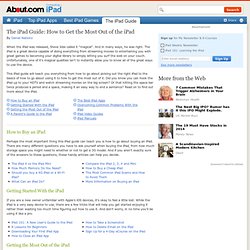
And in many ways, he was right. The iPad is a great device capable of doing everything from streaming movies to entertaining you with great games to becoming your digital library to simply letting you surf the web on your couch. Unfortunately, one of it's magical qualities isn't to instantly allow you to know all of the great ways to use the device. Presentation.io - The Easiest Way To Present Remotely. On June 27 Cisco announced the acquisition of Assemblage, a company that provides the tools and infrastructure to enable simple, one-click browser-to-browser collaboration without the need for downloads, plugins or installations.
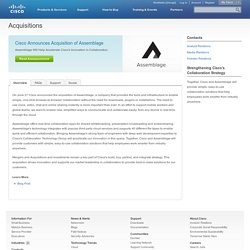
The need to use voice, video, chat and online sharing instantly is more important than ever. In an effort to support mobile workers and global teams, we want to enable new, simplified ways to communicate and collaborate easily, from any device in real-time through the cloud. Assemblage offers real-time collaboration apps for shared whiteboarding, presentation broadcasting and screensharing. Assemblage's technology integrates with popular third party cloud services and supports 40 different file types to enable quick and efficient collaboration. Bringing Assemblage's strong team of engineers with deep web development expertise to Cisco's Collaboration Technology Group will accelerate our innovation in this space. Otter - Create a Simple Page for Distributing and Collecting Assignments. Portfoliogen - Create a Free Customized Teacher Portfolio Website in Minutes!
Portfoliogen - Create a Free Customized Teacher Portfolio Website in Minutes! Classroom management. Online Whiteboard tools. Teaching resources. What the Gifted need. Educational Technology. #TeacherEffectiveness. 10 ways the research behind banning #mlearning for children is flawed. You may have come across Cris Rowan's popular HuffPost piece explaining 10 reasons handheld devices should be banned for children under 12.
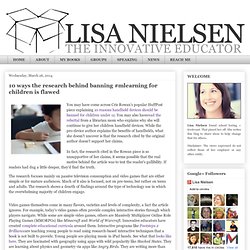
You may also haveread the rebuttal from a librarian mom who explains why she will continue to give her children handheld devices. While the pro-device author explains the benefits of handhelds, what she doesn't uncover is that the research cited by the original author doesn't support her claims. In fact, the research cited in the Rowan piece is so unsupportive of her claims, it seems possible that the real motive behind the article was to test the reader's gullibility. If readers had dug a little deeper, they'd find the truth. The research focuses mainly on passive television consumption and video games that are either simple or for mature audiences. Video games themselves come in many flavors, varieties and levels of complexity, a fact the article ignores. Tech savvy parents and educators know that all these things are good for young people. 10 Points Where the Research Behind Banning Handheld Devices for Children Is Flawed
You may have come across Cris Rowan's popular HuffPost piece explaining 10 reasons handheld devices should be banned for children under 12.
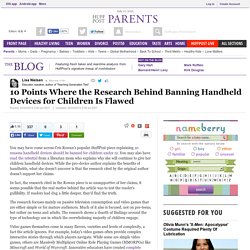
You may also have read the rebuttal from a librarian mom who explains why she will continue to give her children handheld devices. While the pro-device author explains the benefits of handhelds, what she doesn't uncover is that the research cited by the original author doesn't support her claims. In fact, the research cited in the Rowan piece is so unsupportive of her claims, it seems possible that the real motive behind the article was to test the reader's gullibility. If readers had dug a little deeper, they'd find the truth. The research focuses mainly on passive television consumption and video games that are either simple or for mature audiences. Video games themselves come in many flavors, varieties and levels of complexity, a fact the article ignores. Tech savvy parents and educators know that all these things are good for young people. (39) Common Core State Standard Documents, Videos, and Discussions.
What's Your Question? For schools and universities. Present interactively Present your course material with Conceptboard and work live with comments and visual clarifications.
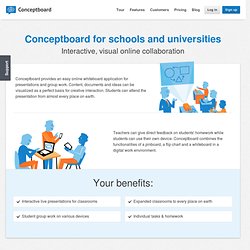
Once created you may copy your content any number of times, develop it further or share it with colleagues. Open board Improve student discussions Conceptboard allows simple discussions of any content. Open board Exchange precise feedback. Www.directionservice.org/cadre/exemplar/artifacts/Encouraging Meaningful Collaboration.pdf. Creating Effective Teacher-Parent Collaborations, Education Up Close, Teaching Today, Glencoe Online. Creating Effective Teacher-Parent Collaborations By forming effective partnerships with parents, teachers can get a boost in helping their students to succeed.
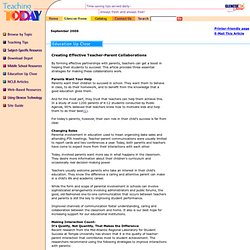
This article provides three essential strategies for making these collaborations work. Parents Want Your Help Parents want their children to succeed in school. They want them to behave in class, to do their homework, and to benefit from the knowledge that a good education gives them. And for the most part, they trust that teachers can help them achieve this. For today's parents, however, their own role in their child's success is far from clear. Www.nasponline.org/communications/spawareness/Parents and Teachers.
Www.nasponline.org/communications/spawareness/Parents and Teachers. Five Steps to Better School/Community Collaboration. As the old African proverb says, "It takes a village to raise a child.
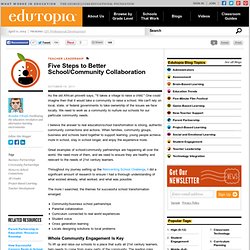
" One could imagine then that it would take a community to raise a school. We can't rely on local, state, or federal governments to take ownership of the issues we face locally. We need to work as a community to nurture our schools for our particular community needs. I believe the answer to real education/school transformation is strong, authentic community connections and actions.
When families, community groups, business and schools band together to support learning, young people achieve more in school, stay in school longer, and enjoy the experience more. Great examples of school/community partnerships are happening all over the world. Throughout my journey setting up the Reinventing School Challenge, I did a significant amount of research to ensure I had a thorough understanding of what existed already, what worked, and what was possible.
The more I searched, the themes for successful school transformation emerged: Www.nccrest.org/Briefs/PractitionerBrief_BuildingCollaboration.pdf. Www.nea.org/assets/docs/Family-School-Community-Partnerships-2.0.pdf. Lisa Nielsen: The Innovative Educator. The Condition of Education - Participation in Education - Elementary/Secondary Enrollment - Racial/Ethnic Enrollment in Public Schools - Indicator March (2013) The Condition of Education - Participation in Education - Elementary/Secondary Enrollment - English Language Learners - Indicator January (2013) The percentage of public school students in the United States who were English language learners (ELL) was higher in 2010-11 (10 percent) than in 2002-03 (9 percent).
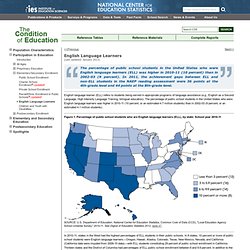
In 2011, the achievement gaps between ELL and non-ELL students in the NAEP reading assessment were 36 points at the 4th-grade level and 44 points at the 8th-grade level. English language learner (ELL) refers to students being served in appropriate programs of language assistance (e.g., English as a Second Language, High Intensity Language Training, bilingual education).
The Condition of Education - Participation in Education - Elementary/Secondary Enrollment - Racial/Ethnic Enrollment in Public Schools - Indicator March (2013) The Condition of Education - Participation in Education - Elementary/Secondary Enrollment - Public School Enrollment - Indicator January (2013) From school years 2010-11 through 2021-22, public elementary and secondary school enrollment is projected to increase by 7 percent from 49.5 to 53.1 million students, but with changes across states ranging from an increase of 22 percent in Alaska to a decrease of 15 percent in the District of Columbia.
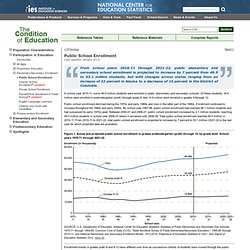
In school year 2010-11, some 49.5 million students were enrolled in public elementary and secondary schools. Of these students, 34.6 million were enrolled in prekindergarten (preK) through grade 8, and 14.9 million were enrolled in grades 9 through 12. Public school enrollment declined during the 1970s and early 1980s and rose in the latter part of the 1980s.